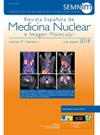Estado del arte y perspectivas futuras de nuevos radionúclidos en Medicina Nuclear: Parte III
IF 1.6
4区 医学
Q3 RADIOLOGY, NUCLEAR MEDICINE & MEDICAL IMAGING
Revista Espanola De Medicina Nuclear E Imagen Molecular
Pub Date : 2025-07-01
DOI:10.1016/j.remn.2025.500161
引用次数: 0
Abstract
In this third installment of the continuing education series, the clinical and therapeutic applications of zirconium, astatine and thorium are analyzed in depth. Although they are not described as theragnostic pairs, each of these radionuclides plays a fundamental role in precision medicine, which is rapidly advancing within Nuclear Medicine.
We begin by analyzing zirconium-89, a positron emitter whose long half-life makes it particularly suitable for labeling large molecules with slow kinetics, such as antibodies, playing a crucial role in immunotherapy. The use of astatine-211, an alpha-emitting radionuclide with a simple decay scheme and chemical behavior similar to iodine, is also discussed. Its main challenge lies in its production, as it requires cyclotrons capable of generating highly energetic alpha particle beams. Furthermore, thorium-227, a 100% alpha emitter, is reviewed. This radionuclide exhibits excellent chelation properties, enabling its conjugation with tumor-targeting molecules to produce thorium-labeled conjugates. While this technique is yielding promising preclinical results, the use of thorium faces challenges, including the potential separation of radium-223 from the molecule and the dependence of activity measurements on the time of production. Since it takes 100 days to reach equilibrium, activity assessment is based on photons emitted by its daughter radionuclides.
Despite these challenges, these radionuclides are driving the evolution of precision medicine, expanding therapeutic and diagnostic possibilities within Nuclear Medicine.
Nuclear Medicine.
核医学中新型放射性核素的现状和未来前景:第三部分
在继续教育系列的第三部分中,深入分析了锆、砹和钍的临床和治疗应用。虽然它们没有被描述为诊断对,但这些放射性核素中的每一种都在精确医学中发挥着重要作用,这在核医学中正在迅速发展。我们首先分析锆-89,它是一种正电子发射器,半衰期长,特别适合标记动力学慢的大分子,如抗体,在免疫治疗中起着至关重要的作用。还讨论了砹-211的使用,它是一种具有简单的衰变机制和类似于碘的化学行为的α -发射放射性核素。它的主要挑战在于它的生产,因为它需要能够产生高能粒子束的回旋加速器。此外,还对100% α发射体钍-227进行了评述。这种放射性核素表现出优异的螯合特性,使其与肿瘤靶向分子结合,产生钍标记的偶联物。虽然这项技术正在产生有希望的临床前结果,但钍的使用面临着挑战,包括从分子中分离镭-223的可能性以及活性测量对生产时间的依赖。由于达到平衡需要100天,因此活动评估是基于其子放射性核素发射的光子。尽管存在这些挑战,但这些放射性核素正在推动精准医学的发展,扩大核医学的治疗和诊断可能性。核医学。
本文章由计算机程序翻译,如有差异,请以英文原文为准。
求助全文
约1分钟内获得全文
求助全文
来源期刊

Revista Espanola De Medicina Nuclear E Imagen Molecular
RADIOLOGY, NUCLEAR MEDICINE & MEDICAL IMAGING-
CiteScore
1.10
自引率
16.70%
发文量
85
审稿时长
24 days
期刊介绍:
The Revista Española de Medicina Nuclear e Imagen Molecular (Spanish Journal of Nuclear Medicine and Molecular Imaging), was founded in 1982, and is the official journal of the Spanish Society of Nuclear Medicine and Molecular Imaging, which has more than 700 members.
The Journal, which publishes 6 regular issues per year, has the promotion of research and continuing education in all fields of Nuclear Medicine as its main aim. For this, its principal sections are Originals, Clinical Notes, Images of Interest, and Special Collaboration articles.
 求助内容:
求助内容: 应助结果提醒方式:
应助结果提醒方式:


